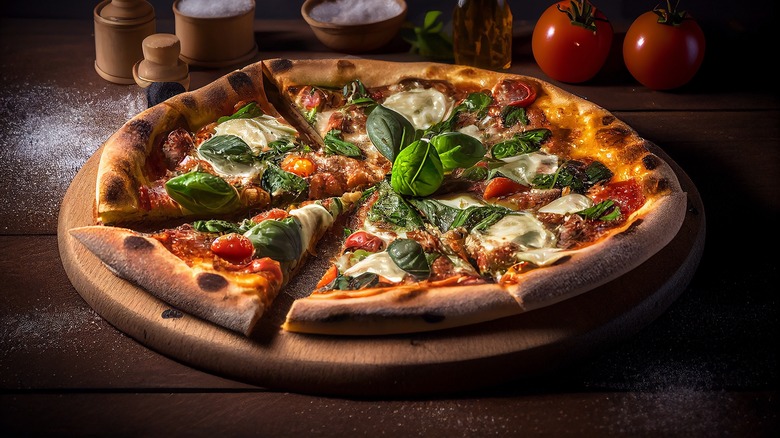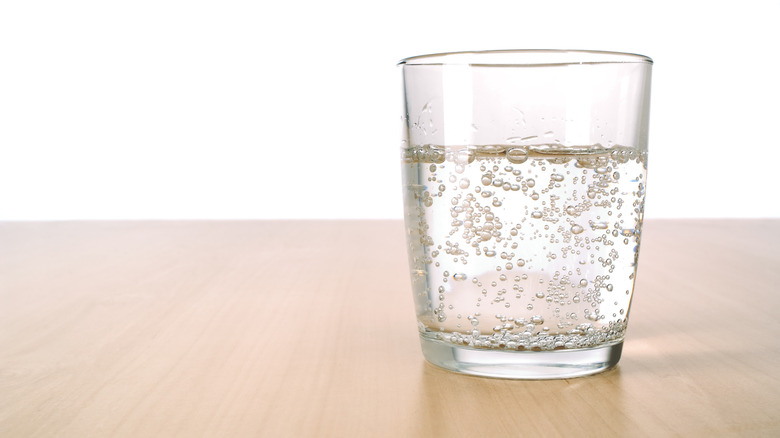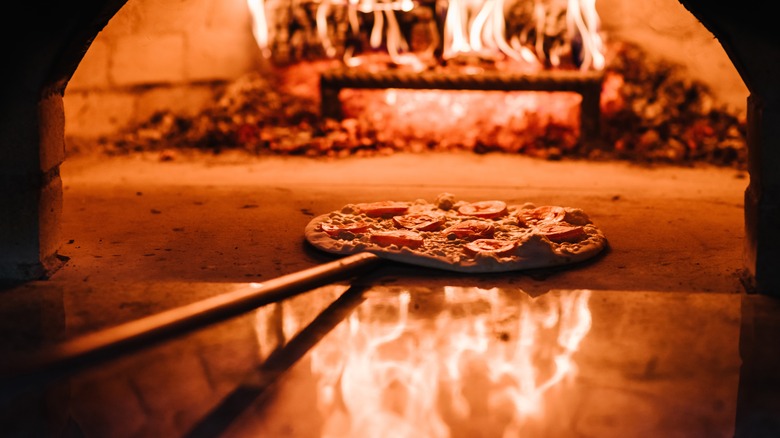Does Club Soda Really Make Pizza Crust Taste Restaurant Worthy?
Social media has gotten us fixated on hacks. It's a busy and frankly overwhelming time to be alive, so if there's a shortcut to be found anywhere, you can bet we're going to take it. Unfortunately, shortcuts don't always lead where you want them to. Some cooking hacks hold up when put to the test, like Julia Child's scrambled egg hack, because they're built on sound kitchen science, but other hacks present more problems than solutions, including one purported shortcut to restaurant-style pizza crust.
Homemade pizza is notoriously tricky because professional pizzerias typically use equipment inaccessible to home cooks. This has given rise to countless articles and videos online advertising easy methods to cheat your way to great pizza. One method you may have come across already claims you can achieve restaurant-worthy crust by using club soda for the dough. The idea is that the carbon dioxide bubbles in the seltzer will be spread throughout the dough, creating air pockets that expand in the oven— essentially performing the same job as yeast. In reality, club soda can be a useful addition to certain types of dough, but pizza dough isn't one of them. In fact, using sparkling water in pizza dough could actually make it worse.
Club soda might ruin the rise on your pizza dough
Ultimately, the bubbles in club soda won't make a difference in the end product of your pizza crust because the water will have gone flat by the time you're ready to bake. Club soda holds its carbonation in a closed bottle because the sealed environment prevents carbon dioxide from escaping, but as soon as you pour the water into your pizza dough, it will begin to lose its fizz. Dough made with sparkling water is best used within 15 minutes, which means that it is only an effective additive to quick breads, and not to yeasted pizza dough, which typically requires hours of proofing time.
Using club soda in your pizza dough could actually make it worse. Yeast is most active at pH levels above 5.0, ideally 5.5, and fortunately for home bakers, it just so happens that tap water in U.S. households tends to fall around 4.3 to 5.3 on the pH scale. However, carbonated water is more acidic, typically falling between 3.0 and 4.0 on the pH scale, which is low enough that it might hinder the yeast's ability to produce gas and make your bread rise. Another complication is the fact that carbonated water holds more bubbles at colder temperatures. However, active dry and instant yeast need warm water, at least 100 degrees Fahrenheit, to achieve optimal activity.
The real secrets of restaurant-quality pizza crust
The best pizzerias aren't using club soda or any other hacks to make their crust. The real secret to restaurant pizza is the ovens they use, which are capable of reaching temperatures of 900 degrees Fahrenheit and above, nearly double the maximum temperature of a typical home oven. This achieves a wonderfully crisp crust with an airy crumb. As a home cook, the best way to approximate a professional pizza oven is to cook on a pizza stone or pizza steel, which you should preheat in your oven for at least an hour before cooking. Set the pizza stone in the upper third of the oven and crank the heat as high as it goes. It won't be quite the same as a restaurant pizza, but it'll be darn close.
You can also elevate your pizza by choosing professional-grade ingredients. For the crust, try baking with double-zero flour (a.k.a. 00 flour or doppio zero). This is the type of flour favored by Italian pizza chefs because it is very finely ground and relatively low in gluten, which makes the dough exceptionally elastic for kneading and shaping. It should also help you achieve a crust that crisps up quickly in the oven and isn't too dense to the tooth.


